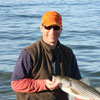Conservation of Natural Marine Ecosystems at the Seagrass Level
By Tom Keer
Nov 09, 2016
Big fish eat little fish, and those little fish grow only if the entire ocean is healthy.
Somewhere in Elementary school we learned that the whole is the sum of the parts. And when it comes to conserving our natural marine resources, that way of thinking creates more fish for us to catch. Forget about the fish...at least for now.
Bottom-up marine conservation is a look at the entire marine ecosystem starting at the most basic level. It's a study of oxygen, nitrogen, water, phytoplankton, and zooplankton, the building blocks of marine biology. They all form the foundation from life, which expands to algae, small invertebrates, and on up to seagrass meadows, coral reefs, and kelp beds. These environments attract baitfish which in turn attracts predators. Natural predators range from shore birds to larger baitfish to gamefish that we anglers target.
Scientists look at lots of different variables to create a healthy marine ecosystem. They study light which regulates photosynthesis that allows plants to make organic material. Temperature is studied to see how toxic chemicals like outboard oil or gas break down or how fish migrate. They examine dissolved oxygen that provides organisms with life, and salinity which, when in balance, promotes proper growth rates. Hydrodynamic setting is the study of current, tides and waves, key factors in the environment.
There is a tremendous amount of threats to marine ecosystems as well. Some, like erosion, naturally creates large amounts of sediment that disturbs the process. Others, like urbanization or the building of docks and bulkheads, are man-made that changes the natural water flow. Sometimes they introduce pollution to the ocean and that impacts water quality which similarly affects the habitat.
Big fish eat little fish, so let's get back to the fishing. We, fishermen, look at the end result of the scientific work. It comes when we study currents and tides to find baitfish and then fish. But in each wave set that contains a Massachusetts bluefish, a Carolina drum or a Florida tarpon are all the right components. The whole is the sum of the parts, and when they're balanced correctly we catch 'em up. The best fishing spots are that way because they're properly conserved our precious marine ecosystems. Check it out – see where to fish and boat!
Bottom-up marine conservation is a look at the entire marine ecosystem starting at the most basic level. It's a study of oxygen, nitrogen, water, phytoplankton, and zooplankton, the building blocks of marine biology. They all form the foundation from life, which expands to algae, small invertebrates, and on up to seagrass meadows, coral reefs, and kelp beds. These environments attract baitfish which in turn attracts predators. Natural predators range from shore birds to larger baitfish to gamefish that we anglers target.
Scientists look at lots of different variables to create a healthy marine ecosystem. They study light which regulates photosynthesis that allows plants to make organic material. Temperature is studied to see how toxic chemicals like outboard oil or gas break down or how fish migrate. They examine dissolved oxygen that provides organisms with life, and salinity which, when in balance, promotes proper growth rates. Hydrodynamic setting is the study of current, tides and waves, key factors in the environment.
There is a tremendous amount of threats to marine ecosystems as well. Some, like erosion, naturally creates large amounts of sediment that disturbs the process. Others, like urbanization or the building of docks and bulkheads, are man-made that changes the natural water flow. Sometimes they introduce pollution to the ocean and that impacts water quality which similarly affects the habitat.
Big fish eat little fish, so let's get back to the fishing. We, fishermen, look at the end result of the scientific work. It comes when we study currents and tides to find baitfish and then fish. But in each wave set that contains a Massachusetts bluefish, a Carolina drum or a Florida tarpon are all the right components. The whole is the sum of the parts, and when they're balanced correctly we catch 'em up. The best fishing spots are that way because they're properly conserved our precious marine ecosystems. Check it out – see where to fish and boat!
Popular Posts









